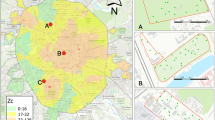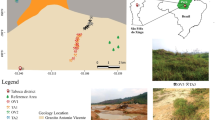Abstract
This is a study of the atmospheric-origin natural radionuclides (7Be and 210Pb) and a wide range of micro- and macro-element accumulation in mosses, lichens, cedar and larch needles in Arctic western Siberia (Yamal-Nenets Autonomous District). Based on the specific activities measurements of atmospheric precipitation markers (7Be and 210Pb), this study found that the concentration of dust particles in the studied objects incrementally increases in the following order, from lowest concentration to highest: cedar needles, larch needles, lichens and mosses. Concentrations of Zr, Hf, Ti, Th, Fe, V, Li, Na, Si, Be, Y, rare earth elements (REE) and Sc in this area also increase in the same ascending sequence. Enrichment factors of these elements (EF) relative to the North American Shale Composite (NASC) are close to unity, which proves their terrigenous origin. Also, the terrigenous origin of the elements in the studied biological objects is confirmed by their high correlation coefficients with Sc. This means that their concentration in the studied biological objects is the result of a background of solid atmospheric precipitation. Enrichment factors of biogenic elements and their analogues (P, Se, Mn, Mg, Ca, K, Zn, Sr, Ba, Rb, Cs) are significantly greater than unity, and this is associated with high concentrations of these elements in the biological part of the samples. A radially symmetric distribution of Pb content in biological objects is observed over the surface of the studied area (with a center located within the city of Novy Urengoy). This leads to the conclusion that there is a point source around which anthropogenic precipitation of Pb takes place. This distribution is most clearly manifested by the example of larch and cedar needles. Anthropogenic deposition of other elements has not been detected in this study area.








Similar content being viewed by others
References
Aboal JR, Couto JA, Fernandez JA, Carballeira A (2006) Definition and number of subsamples for using mosses as biomonitors of airborne trace elements. Arch Environ Contam Toxicol 50:88–96. https://doi.org/10.1007/s00244-005-7006-9
Aboal JR, Fernandez JA, Couto JA, Carballeira A (2008) Testing differences in methods of preparing moss samples. Environ Monit Assess 137:371–378. https://doi.org/10.1007/s10661-007-9772-5
Aboal JR, Fernández JA, Boquete T, Carballeira A (2010) Is it possible to estimate atmospheric deposition of heavy metals by analysis of terrestrial mosses? Sci Total Environ 408:6291–6297. https://doi.org/10.1016/j.scitotenv.2010.09.013
Aboal JR, Boquete MT, Carballeira A, Casanova A, Deben S, Fernandez JA (2017) Quantification of the overall measurement uncertainty associated with the passive moss biomonitoring technique: sample collection and processing. Environ Pollut 224:235–242. https://doi.org/10.1016/j.envpol.2017.01.084
Aleksiayenak YV, Frontasyeva MV, Florek M, Sykora Y, Holy K, Masarik J, Brestakova L, Jeskovsky M, Steinnes E, Faanhof A, Ramatlhape KI (2013) Distributions of 137Cs and 210Pb in moss collected from Belarus and Slovakia. J Environ Radioact 117:19–24. https://doi.org/10.1016/j.jenvrad.2012.01.018
Aničić M, Frontasyeva MV, Tomašević M, Popović A (2007) Assessment of atmospheric dposition of heavy metals and other elements in belgrade using the moss biomonitoring technique and neutron activation analysis. Environ Monit Assess 129:207–219. https://doi.org/10.1007/s10661-006-9354-y
Bagheri R, Mehregan S, Yousefi A, Mirrezaei E (2017) Cosmogenic radionuclide 7Be concentration in seven species of lichens and its correlation with 40K, 137Cs and 226Ra Int. J Environ Sci Technol 14:2443–2450. https://doi.org/10.1007/s13762-017-1312-4
Baskaran M, Shaw GE (2001) Residence time of arctic haze aerosols using the concentrations and activity ratios of 210Po, 210Pb and 7Be. J Aerosol Sci 32:443–452. https://doi.org/10.1016/S0021-8502(00)00093-8
Boquete MT, Fernandez JA, Aboal JR, Carballeira A (2011) Analysis of temporal variability in the concentrations of some elements in the terrestrial moss Pseudoscleropodium purum. Environ Exp Bot 72:210–216. https://doi.org/10.1016/j.envexpbot.2011.03.002
Boquete MT, Aboal JR, Carballeira A, Fernandez JA (2014) Effect of age on the heavy metal concentration in segments of Pseudoscleropodium purum and the biomonitoring of atmospheric deposition of metals. Atmos Environ 86:28–34. https://doi.org/10.1016/j.atmosenv.2013.12.039
Boquete MT, Aboal JR, Carballeira A, Fernández JA (2017) Do mosses exist outside of Europe? A biomonitoring reflection. Sci Total Environ 593–594:567–570. https://doi.org/10.1016/j.scitotenv.2017.03.196
Dowdall M, Gwynn JP, Moran C, O’Dea J, Davids C, Lind B (2005) Uptake of radionuclides by vegetation at a High Arctic location. Environ Pollut 133:327–332. https://doi.org/10.1016/j.envpol.2004.05.032
Fernandez JA, Carballeira A (2002) Biomonitoring metal deposition in Galicia (NW Spain) with mosses: factors affecting bioconcentration. Chemosphere 46:535–542. https://doi.org/10.1016/S0045-6535(01)00060-1
Fernandez JA, Aboal JR, Couto J, Carballeira A (2002) Sampling optimization at the samplingјsite scale for monitoring atmospheric deposition using moss chemistry. Atmos Environ 36:1163–1172. https://doi.org/10.1016/S1352-2310(01)00575-1
Fernandez JA, Aboal JR, Carballeira A (2010) Testing differences in methods of preparing moss samples. Effect of washing on Pseudoscleropodium purum. Environ Monit Assess 163:669–684. https://doi.org/10.1007/s10661-009-0867-z
Gavshin VM, Melgunov MS, Sukhorukov FV, Bobrov VA, Kalugin IA, Klerkx J (2005) Disequilibrium between uranium and its progeny in the Lake Issyk-Kul system (Kyrgyzstan) under a combined effect of natural and manmade processes. J Environ Radioact 83:61–74. https://doi.org/10.1016/j.jenvrad.2005.02.012
Hashimoto Y, Sekine Y, Otoshi T (1992) Atmospheric aluminum from human activities. Atmos Environ 26:295–300. https://doi.org/10.1016/0957-1272(92)90005-D
Ioannidou A (2011) Activity size distribution of 7Be in association with trace metals in the urban area of the city of Thessaloniki, Greece. Atmos Environ 45:1286–1290. https://doi.org/10.1016/j.atmosenv.2010.12.006
Kabata-Pendias A, Pendias H (1989) Microelements in soils and plants. Mir, Moscow
Leppänen AP (2019) Deposition of naturally occurring 7Be and 210Pb in Northern Finland. J Environ Radioact 208:105995. https://doi.org/10.1016/j.jenvrad.2019.105995
Li Y (1991) Distribution patterns of the elements in the ocean: a synthesis. Geochim Cosmochim Acta 55:3223–3240. https://doi.org/10.1016/0016-7037(91)90485-N
Malikova IN, Strakhovenko VD, Shcherbov BL (2019) Distribution of radionuclides in moss-lichen cover and needles on the same grounds of landscape-climatic zones of Siberia. J Environ Radioact 198:64–78. https://doi.org/10.1016/j.jenvrad.2018.12.013
Popovic D, Todorovic D, Frontasyeva M, Ajtic J, Tasic M, Rajsic S (2008) Radionuclides and heavy metals in Borovac, Southern Serbia. Environ Sci Pollut Res 15:509–520. https://doi.org/10.1007/s11356-008-0003-6
Salemaa M, Derome J, Helmisaari HS, Nieminen T, Vanha-Majamaa I (2004) Element accumulation in boreal bryophytes, lichens and vascular plants exposed to heavy metal and sulphur deposition in Finland. Sci Total Environ 324:141–160. https://doi.org/10.1016/j.scitotenv.2003.10.025
Shcherbov BL, Strakhovenko VD, Malikova IN, Osipova LP, Sukhorukov FV, Stepin AS (2000) Comparative characteristics of modern radioactive pollution of West Siberian territories adjacent to the Semipalatinsk and Novaya Zemlya testing. Siberian J Ecol 7:51–60 (in Russian)
Špičková J, Navrátil T, Rohovec J, Mihaljevic M, Kubínová P, MinarˇíkL, Skrˇivan P (2010) The characteristics of rare earth elements in bulk precipitation, throughfall, foliage and lichens in the Lesní potok catchment and its vicinity, Czech Republic. Geochem-Explor Env A 10:383–390. https://doi.org/10.1144/1467-7873/09-225
Tretiach M, Pittao E, Crisafulli P, Adamo P (2011) Influence of exposure sites on trace element enrichment in mos s-bags and characterization of particles deposited on the biomonitor surface. Sci Total Environ 409:822–830. https://doi.org/10.1016/j.scitotenv.2010.10.026
Urošević MA, Vuković G, Vasić P, Jakšić T, Nikolić D, Škrivanj D, Popović A (2018) Environmental implication indices from elemental characterizations of collocated topsoil and moss samples. Ecol Indic 90:529–539. https://doi.org/10.1016/j.ecolind.2018.03.048
Varela Z, Fernandez JA, Aboal JR, Real C, Carballeira A (2010) Determination of the optimal size of area to be sampled by use of the moss biomonitoring technique. J Atmos Chem 65:37–48. https://doi.org/10.1007/s10874-010-9180-z
Zhang L, Gong S, Padro J, Barrie L (2001) A size-segregated particle dry deposition scheme for an atmospheric aerosol module. Atmos Environ 35:549–560. https://doi.org/10.1016/S1352-2310(00)00326-5
Acknowledgements
Analytical studies were carried out in the Analytical Center for multi-element and isotope research SB RAS.
Funding
All field and analytical studies were supported by grant from the Russian Science Foundation (project No 18-77-10039). Adaptation of gamma spectrometry methods supported by the state assignment IGM SB RAS.
Author information
Authors and Affiliations
Corresponding author
Additional information
Responsible Editor: Georg Steinhauser
Publisher’s note
Springer Nature remains neutral with regard to jurisdictional claims in published maps and institutional affiliations.
Rights and permissions
About this article
Cite this article
Vosel, Y., Belyanin, D., Melgunov, M. et al. Accumulation of natural radionuclides (7Be, 210Pb) and micro-elements in mosses, lichens and cedar and larch needles in the Arctic Western Siberia. Environ Sci Pollut Res 28, 2880–2892 (2021). https://doi.org/10.1007/s11356-020-10615-4
Received:
Accepted:
Published:
Issue Date:
DOI: https://doi.org/10.1007/s11356-020-10615-4




